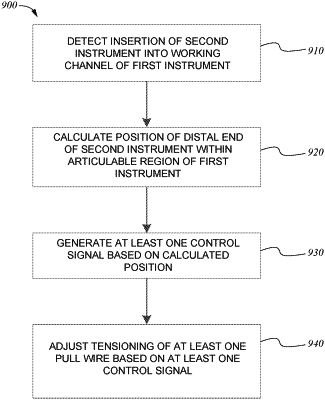| CPC A61B 34/30 (2016.02) [A61B 1/00147 (2013.01); A61B 1/00149 (2013.01); A61B 1/0016 (2013.01); A61B 1/0051 (2013.01); A61B 1/018 (2013.01); A61B 1/2676 (2013.01); A61B 5/062 (2013.01); A61B 5/067 (2013.01); A61B 34/20 (2016.02); A61B 34/71 (2016.02); A61B 90/361 (2016.02); A61B 90/90 (2016.02); A61B 5/0803 (2013.01); A61B 2017/00809 (2013.01); A61B 2034/2048 (2016.02); A61B 2034/2051 (2016.02); A61B 2034/2059 (2016.02); A61B 2034/2065 (2016.02); A61B 34/25 (2016.02); A61B 2090/309 (2016.02); A61B 2090/3614 (2016.02); A61B 2090/376 (2016.02); A61B 90/39 (2016.02); A61B 2090/3966 (2016.02); A61B 90/96 (2016.02); A61B 90/98 (2016.02)] | 20 Claims |

|
1. A method of controlling an instrument, the method comprising:
determining a position of a second instrument within a working channel of a shaft of a first instrument;
in response to determining the position of the second instrument, predict a position change of a distal end of the shaft that would be caused by further advancement of the second instrument within the working channel of the first instrument; and
generating at least one control signal based on the predicted position change of the distal end of the shaft to control articulation of the first instrument to compensate for the further advancement of the second instrument within the working channel of the first instrument.
|